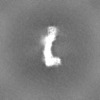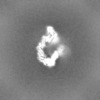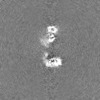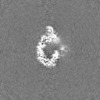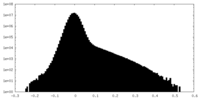[English] 日本語
 Yorodumi
Yorodumi- EMDB-19567: Closed crosslinked structure of (NEDD8)-CRL2VHL-MZ1-Brd4BD2-Ub(G7... -
+ Open data
Open data
- Basic information
Basic information
| Entry |  | ||||||||||||||||||
|---|---|---|---|---|---|---|---|---|---|---|---|---|---|---|---|---|---|---|---|
| Title | Closed crosslinked structure of (NEDD8)-CRL2VHL-MZ1-Brd4BD2-Ub(G76S, K48C)-UBE2R1(C93K, S138C, C191S, C223S)-Ub | ||||||||||||||||||
 Map data Map data | Cryo-EM structure of the (NEDD8)-CRL2VHL-MZ1-Brd4BD2 ternary complex primed for catalysis with UBE2R1-Ub. | ||||||||||||||||||
 Sample Sample |
| ||||||||||||||||||
 Keywords Keywords | E3 ligase / Cullin / PROTAC / BET bromodomain / LIGASE | ||||||||||||||||||
| Function / homology |  Function and homology information Function and homology informationregulation of cellular response to hypoxia / cullin-RING-type E3 NEDD8 transferase / NEDD8 transferase activity / cullin-RING ubiquitin ligase complex / RHOBTB3 ATPase cycle / negative regulation of receptor signaling pathway via JAK-STAT / (E3-independent) E2 ubiquitin-conjugating enzyme / Cul7-RING ubiquitin ligase complex / ubiquitin-dependent protein catabolic process via the C-end degron rule pathway / cellular response to chemical stress ...regulation of cellular response to hypoxia / cullin-RING-type E3 NEDD8 transferase / NEDD8 transferase activity / cullin-RING ubiquitin ligase complex / RHOBTB3 ATPase cycle / negative regulation of receptor signaling pathway via JAK-STAT / (E3-independent) E2 ubiquitin-conjugating enzyme / Cul7-RING ubiquitin ligase complex / ubiquitin-dependent protein catabolic process via the C-end degron rule pathway / cellular response to chemical stress / Loss of Function of FBXW7 in Cancer and NOTCH1 Signaling / transcription elongation factor activity / target-directed miRNA degradation / elongin complex / positive regulation of protein autoubiquitination / RNA polymerase II transcription initiation surveillance / protein neddylation / hypothalamus gonadotrophin-releasing hormone neuron development / Replication of the SARS-CoV-1 genome / NEDD8 ligase activity / female meiosis I / VCB complex / positive regulation of protein monoubiquitination / negative regulation of response to oxidative stress / Cul5-RING ubiquitin ligase complex / fat pad development / mitochondrion transport along microtubule / SCF ubiquitin ligase complex / negative regulation of type I interferon production / ubiquitin-ubiquitin ligase activity / Cul2-RING ubiquitin ligase complex / intracellular membraneless organelle / E2 ubiquitin-conjugating enzyme / SCF-dependent proteasomal ubiquitin-dependent protein catabolic process / Cul4A-RING E3 ubiquitin ligase complex / Cul4-RING E3 ubiquitin ligase complex / Cul3-RING ubiquitin ligase complex / Cul4B-RING E3 ubiquitin ligase complex / ubiquitin ligase complex scaffold activity / female gonad development / negative regulation of mitophagy / SUMOylation of ubiquitinylation proteins / seminiferous tubule development / Prolactin receptor signaling / male meiosis I / RNA polymerase II C-terminal domain binding / ubiquitin conjugating enzyme activity / TGF-beta receptor signaling activates SMADs / cullin family protein binding / P-TEFb complex binding / negative regulation of DNA damage checkpoint / regulation of proteolysis / positive regulation of intrinsic apoptotic signaling pathway by p53 class mediator / histone H4 reader activity / Pausing and recovery of Tat-mediated HIV elongation / Tat-mediated HIV elongation arrest and recovery / negative regulation of transcription elongation by RNA polymerase II / regulation of postsynapse assembly / HIV elongation arrest and recovery / Pausing and recovery of HIV elongation / anatomical structure morphogenesis / host-mediated suppression of viral transcription / DNA replication initiation / protein monoubiquitination / positive regulation of G2/M transition of mitotic cell cycle / negative regulation of signal transduction / Tat-mediated elongation of the HIV-1 transcript / positive regulation of T-helper 17 cell lineage commitment / Formation of HIV-1 elongation complex containing HIV-1 Tat / ubiquitin-like ligase-substrate adaptor activity / protein K48-linked ubiquitination / Formation of HIV elongation complex in the absence of HIV Tat / cellular response to interferon-beta / Nuclear events stimulated by ALK signaling in cancer / energy homeostasis / RNA Polymerase II Transcription Elongation / regulation of neuron apoptotic process / Formation of RNA Pol II elongation complex / neuron projection morphogenesis / : / regulation of proteasomal protein catabolic process / negative regulation of TORC1 signaling / Maturation of protein E / Maturation of protein E / transcription-coupled nucleotide-excision repair / ER Quality Control Compartment (ERQC) / Myoclonic epilepsy of Lafora / FLT3 signaling by CBL mutants / Prevention of phagosomal-lysosomal fusion / IRAK2 mediated activation of TAK1 complex / RNA Polymerase II Pre-transcription Events / Alpha-protein kinase 1 signaling pathway / Glycogen synthesis / IRAK1 recruits IKK complex / IRAK1 recruits IKK complex upon TLR7/8 or 9 stimulation / positive regulation of TORC1 signaling / Endosomal Sorting Complex Required For Transport (ESCRT) / Membrane binding and targetting of GAG proteins / Negative regulation of FLT3 / Regulation of TBK1, IKKε (IKBKE)-mediated activation of IRF3, IRF7 Similarity search - Function | ||||||||||||||||||
| Biological species |  Homo sapiens (human) Homo sapiens (human) | ||||||||||||||||||
| Method | single particle reconstruction / cryo EM / Resolution: 3.7 Å | ||||||||||||||||||
 Authors Authors | Ciulli A / Crowe C / Nakasone MA | ||||||||||||||||||
| Funding support | European Union,  United Kingdom, United Kingdom,  Switzerland, 5 items Switzerland, 5 items
| ||||||||||||||||||
 Citation Citation |  Journal: Sci Adv / Year: 2024 Journal: Sci Adv / Year: 2024Title: Mechanism of degrader-targeted protein ubiquitinability. Authors: Charlotte Crowe / Mark A Nakasone / Sarah Chandler / Conner Craigon / Gajanan Sathe / Michael H Tatham / Nikolai Makukhin / Ronald T Hay / Alessio Ciulli /  Abstract: Small-molecule degraders of disease-driving proteins offer a clinically proven modality with enhanced therapeutic efficacy and potential to tackle previously undrugged targets. Stable and long-lived ...Small-molecule degraders of disease-driving proteins offer a clinically proven modality with enhanced therapeutic efficacy and potential to tackle previously undrugged targets. Stable and long-lived degrader-mediated ternary complexes drive fast and profound target degradation; however, the mechanisms by which they affect target ubiquitination remain elusive. Here, we show cryo-EM structures of the VHL Cullin 2 RING E3 ligase with the degrader MZ1 directing target protein Brd4 toward UBE2R1-ubiquitin, and Lys at optimal positioning for nucleophilic attack. In vitro ubiquitination and mass spectrometry illuminate a patch of favorably ubiquitinable lysines on one face of Brd4, with cellular degradation and ubiquitinomics confirming the importance of Lys and nearby Lys/Lys, identifying the "ubiquitination zone." Our results demonstrate the proficiency of MZ1 in positioning the substrate for catalysis, the favorability of Brd4 for ubiquitination by UBE2R1, and the flexibility of CRL2 for capturing suboptimal lysines. We propose a model for ubiquitinability of degrader-recruited targets, providing a mechanistic blueprint for further rational drug design. #1:  Journal: Biorxiv / Year: 2024 Journal: Biorxiv / Year: 2024Title: Mechanism of degrader-targeted protein ubiquitinability Authors: Crowe C / Nakasone MA / Chandler S / Tatham MH / Makukhin N / Hay RT / Ciulli A | ||||||||||||||||||
| History |
|
- Structure visualization
Structure visualization
| Supplemental images |
|---|
- Downloads & links
Downloads & links
-EMDB archive
| Map data |  emd_19567.map.gz emd_19567.map.gz | 398.5 MB |  EMDB map data format EMDB map data format | |
|---|---|---|---|---|
| Header (meta data) |  emd-19567-v30.xml emd-19567-v30.xml emd-19567.xml emd-19567.xml | 14.2 KB 14.2 KB | Display Display |  EMDB header EMDB header |
| FSC (resolution estimation) |  emd_19567_fsc.xml emd_19567_fsc.xml | 15.9 KB | Display |  FSC data file FSC data file |
| Images |  emd_19567.png emd_19567.png | 110.9 KB | ||
| Filedesc metadata |  emd-19567.cif.gz emd-19567.cif.gz | 4.3 KB | ||
| Others |  emd_19567_half_map_1.map.gz emd_19567_half_map_1.map.gz emd_19567_half_map_2.map.gz emd_19567_half_map_2.map.gz | 391.3 MB 391.3 MB | ||
| Archive directory |  http://ftp.pdbj.org/pub/emdb/structures/EMD-19567 http://ftp.pdbj.org/pub/emdb/structures/EMD-19567 ftp://ftp.pdbj.org/pub/emdb/structures/EMD-19567 ftp://ftp.pdbj.org/pub/emdb/structures/EMD-19567 | HTTPS FTP |
-Validation report
| Summary document |  emd_19567_validation.pdf.gz emd_19567_validation.pdf.gz | 859.6 KB | Display |  EMDB validaton report EMDB validaton report |
|---|---|---|---|---|
| Full document |  emd_19567_full_validation.pdf.gz emd_19567_full_validation.pdf.gz | 859.1 KB | Display | |
| Data in XML |  emd_19567_validation.xml.gz emd_19567_validation.xml.gz | 24.9 KB | Display | |
| Data in CIF |  emd_19567_validation.cif.gz emd_19567_validation.cif.gz | 32.3 KB | Display | |
| Arichive directory |  https://ftp.pdbj.org/pub/emdb/validation_reports/EMD-19567 https://ftp.pdbj.org/pub/emdb/validation_reports/EMD-19567 ftp://ftp.pdbj.org/pub/emdb/validation_reports/EMD-19567 ftp://ftp.pdbj.org/pub/emdb/validation_reports/EMD-19567 | HTTPS FTP |
-Related structure data
| Related structure data | 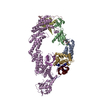 8rx0MC  8rwzC C: citing same article ( M: atomic model generated by this map |
|---|---|
| Similar structure data | Similarity search - Function & homology  F&H Search F&H Search |
- Links
Links
| EMDB pages |  EMDB (EBI/PDBe) / EMDB (EBI/PDBe) /  EMDataResource EMDataResource |
|---|---|
| Related items in Molecule of the Month |
- Map
Map
| File |  Download / File: emd_19567.map.gz / Format: CCP4 / Size: 421.9 MB / Type: IMAGE STORED AS FLOATING POINT NUMBER (4 BYTES) Download / File: emd_19567.map.gz / Format: CCP4 / Size: 421.9 MB / Type: IMAGE STORED AS FLOATING POINT NUMBER (4 BYTES) | ||||||||||||||||||||||||||||||||||||
|---|---|---|---|---|---|---|---|---|---|---|---|---|---|---|---|---|---|---|---|---|---|---|---|---|---|---|---|---|---|---|---|---|---|---|---|---|---|
| Annotation | Cryo-EM structure of the (NEDD8)-CRL2VHL-MZ1-Brd4BD2 ternary complex primed for catalysis with UBE2R1-Ub. | ||||||||||||||||||||||||||||||||||||
| Projections & slices | Image control
Images are generated by Spider. | ||||||||||||||||||||||||||||||||||||
| Voxel size | X=Y=Z: 0.825 Å | ||||||||||||||||||||||||||||||||||||
| Density |
| ||||||||||||||||||||||||||||||||||||
| Symmetry | Space group: 1 | ||||||||||||||||||||||||||||||||||||
| Details | EMDB XML:
|
-Supplemental data
-Half map: #1
| File | emd_19567_half_map_1.map | ||||||||||||
|---|---|---|---|---|---|---|---|---|---|---|---|---|---|
| Projections & Slices |
| ||||||||||||
| Density Histograms |
-Half map: #2
| File | emd_19567_half_map_2.map | ||||||||||||
|---|---|---|---|---|---|---|---|---|---|---|---|---|---|
| Projections & Slices |
| ||||||||||||
| Density Histograms |
- Sample components
Sample components
-Entire : Closed crosslinked structure of (NEDD8)-CRL2VHL-MZ1-Brd4BD2-Ub(G7...
| Entire | Name: Closed crosslinked structure of (NEDD8)-CRL2VHL-MZ1-Brd4BD2-Ub(G76S, K48C)-UBE2R1(C93K, S138C, C191S, C223S)-Ub |
|---|---|
| Components |
|
-Supramolecule #1: Closed crosslinked structure of (NEDD8)-CRL2VHL-MZ1-Brd4BD2-Ub(G7...
| Supramolecule | Name: Closed crosslinked structure of (NEDD8)-CRL2VHL-MZ1-Brd4BD2-Ub(G76S, K48C)-UBE2R1(C93K, S138C, C191S, C223S)-Ub type: complex / ID: 1 / Parent: 0 |
|---|---|
| Source (natural) | Organism:  Homo sapiens (human) Homo sapiens (human) |
| Molecular weight | Theoretical: 190 kDa/nm |
-Experimental details
-Structure determination
| Method | cryo EM |
|---|---|
 Processing Processing | single particle reconstruction |
| Aggregation state | particle |
- Sample preparation
Sample preparation
| Buffer | pH: 7.8 |
|---|---|
| Vitrification | Cryogen name: ETHANE |
- Electron microscopy
Electron microscopy
| Microscope | TFS KRIOS |
|---|---|
| Image recording | Film or detector model: GATAN K3 BIOQUANTUM (6k x 4k) / Average electron dose: 38.0 e/Å2 |
| Electron beam | Acceleration voltage: 300 kV / Electron source:  FIELD EMISSION GUN FIELD EMISSION GUN |
| Electron optics | C2 aperture diameter: 50.0 µm / Illumination mode: FLOOD BEAM / Imaging mode: BRIGHT FIELD / Cs: 2.7 mm / Nominal defocus max: 2.7 µm / Nominal defocus min: 1.2 µm |
| Experimental equipment |  Model: Titan Krios / Image courtesy: FEI Company |
 Movie
Movie Controller
Controller


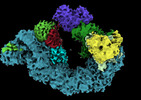





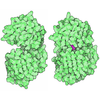




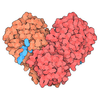







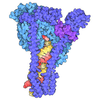
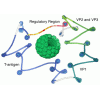







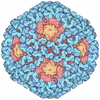

 Z (Sec.)
Z (Sec.) Y (Row.)
Y (Row.) X (Col.)
X (Col.)





















